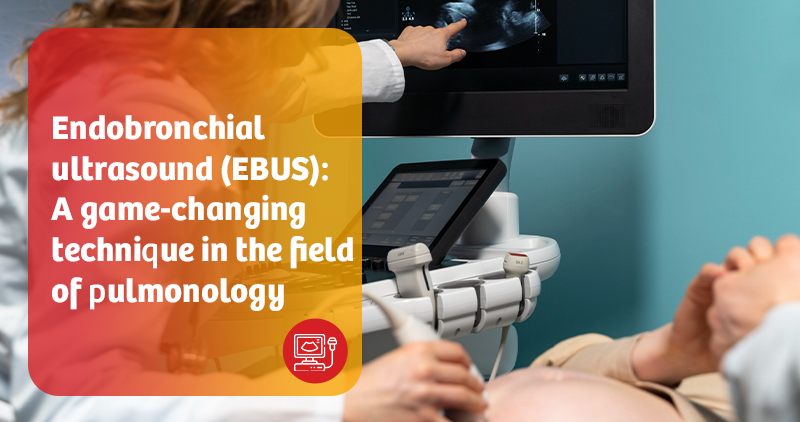
Modern medicine continues to evolve with remarkable precision and less invasive techniques. One such revolutionary advancement in pulmonology is endobronchial ultrasound (EBUS), which has transformed the landscape of diagnosing lung diseases, especially lung cancer. With the increasing burden of respiratory illnesses in India and worldwide, timely and accurate diagnosis has become the cornerstone of effective treatment. EBUS stands at the forefront of this diagnostic revolution.
At KD Hospital, Ahmedabad, we offer cutting-edge interventional pulmonology services, including EBUS with radial probe and convex probe technologies, under one roof. Backed by advanced equipment, expert specialists, and a patient-centric approach, our mission is to provide safe, precise, and minimally invasive diagnosis and care.
EBUS is an advanced, minimally invasive bronchoscopic technique that combines bronchoscopy with real-time ultrasound imaging. It enables pulmonologists to visualise and access parts of the lungs and mediastinum (the central chest area) that traditional bronchoscopes cannot reach directly.
Unlike traditional bronchoscopy, EBUS-guided biopsies provide access to deeper structures such as lymph nodes, peripheral lung nodules and masses, making them invaluable for diagnosing conditions like lung cancer, tuberculosis, sarcoidosis, and lymphomas.
There are two main types of EBUS used in clinical practice.
EBUS is especially valuable in evaluating
The power of EBUS lies in its ability to combine accuracy, safety, and efficiency. Let’s explore its key advantages.
EBUS provides real-time imaging, enabling precise sampling of lesions or lymph nodes, resulting in a higher diagnostic yield compared to blind biopsy techniques.
Accurate staging determines the extent of cancer spread. EBUS is now the preferred method for mediastinal staging, critical for planning lung cancer treatment strategies.
Compared to surgical procedures like mediastinoscopy, EBUS is significantly less invasive, with reduced complications and quicker recovery.
It helps diagnose a range of conditions beyond cancer, such as sarcoidosis, granulomatous diseases, lymphomas, and even infectious diseases like tuberculosis.
Most patients can return home on the same day, eliminating the need for hospitalisation.
At KD Hospital, EBUS is performed in a sterile bronchoscopy suite by trained pulmonologists, supported by skilled anesthesiologists and nursing staff.
| Feature | EBUS | Mediastinoscopy |
| Invasiveness | Minimally invasive | Surgical procedure |
| Anaesthesia | Conscious sedation/general | General anaesthesia |
| Hospital stay | Daycare | Requires hospitalisation |
| Recovery time | 24 hours | Several days |
| Complications | Low | Higher (bleeding, infection) |
| Diagnostic yield | High (90%+) | Comparable but more invasive |
KD Hospital is among the few leading centres in Gujarat offering advanced EBUS with both radial and convex probes. Our interventional pulmonology department aims to provide precise diagnoses while prioritising patient safety and comfort.
Patients referred to a pulmonologist with any of the following concerns may benefit from EBUS
If you or your loved one fits any of the above profiles, consult Gujarat’s best pulmonology experts at KD Hospital for further evaluation.
Is EBUS painful?
No. The procedure is performed under sedation or anaesthesia. Patients feel little to no discomfort.
How long does the procedure take?
The actual procedure takes around 30–60 minutes, depending on the number of biopsies required.
Is EBUS safe?
Yes. It is a very safe technique with low complication rates compared to surgical methods.
How long is the recovery time?
Most patients resume normal activities within 24 hours of the procedure.
Can EBUS diagnose all lung diseases?
While EBUS is effective for central and some peripheral lesions, very small or deeply located lesions may require additional procedures, such as CT-guided biopsy.
How soon will I get the results?
Preliminary results are typically available within 24 to 48 hours, while complete histopathological reports may take up to 5 to 7 days.
A new era in lung diagnostics
With lung cancer and other pulmonary diseases on the rise, early diagnosis is the key to better outcomes. EBUS offers a safe, efficient, and accurate method for diagnosing thoracic conditions, eliminating the need for open surgeries in many cases.
We are dedicated to delivering comprehensive respiratory care, driven by advanced technology and led by a team of experienced specialists. If you or someone you know is facing undiagnosed lung symptoms or suspected thoracic pathology, EBUS could be the gateway to early detection and treatment.